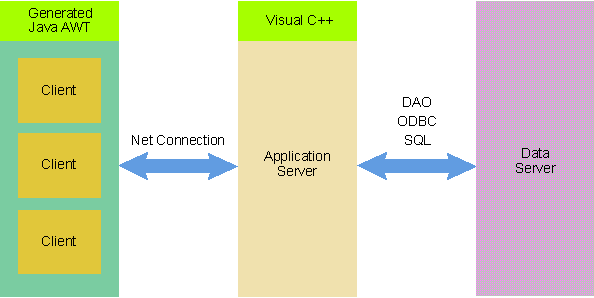
The litmus test just created effectively defines a new application architecture for the Internet. This model, which I call the thin client three-tier architecture, can be differentiated from the traditional three-tier client/server approach in two ways. First of all, in the thin client model, all the application-specific logic is running on the server. The logic could be distributed on the server side over many machines, but the approach is inherently server-side. Secondly, in the thin client model, only state changes are exchanged between the client and the server. In the traditional three-tier model the communication between the client and the server is based on remote procedure calls (RPCs). Implementing an application with RPCs requires application-specific logic on the client. Application partitioning is typically left to the developer. The problem with the traditional three-tier architecture with respect to the Internet is that it exhibits many fat client characteristics. It is important to note that a thin client approach allows objects to be accessed by multiple clients simultaneously and in real time.
Traditional client/server approaches, allowing only a single client to access a server process, were OK for the single-user desktop application, but inadequate and too inflexible given the multiclient access capabilities of the Web. Traditionally, multiuser access to data was limited to the multiuser capabilities of the database engine. The thin client approach enables multiuser control of data and services of application objects. The traditional client/server approach controls data and services at the level of the database engine where the context of the data with respect to its associated logic is limited or nonexistent.
Let’s take a look at the implementation of the thin client three-tier architecture. Client, server, and database pieces can be interchangeable. The Java AWT toolkit provides the API for the user interface of an application. The presentation layer (the thin client) can actually be an applet downloaded from the server and run within an Internet browser. The applet contains user-interface widgets such as scroll bars and buttons and enough embedded network communication machinery to respond to and initiate state changes between the client and the server.
A client-side visual element is associated with a specific server-side object. For example, an AWT edit box on the client can be “connected” to a data member of a C++ object running on the server. When a value is typed into the edit box on the client-side applet, a data state change message is sent to the server. In this example, an edit box is a Java applet with a “network” line connected to a server-side object’s data member. Any other clients viewing that data member through their interfaces will also update automatically to reflect the object’s new state.
Although the client is small, it is also smart enough to know the kind of C++ objects running on the server to which it is connected. The client sends network messages when the user interacts with the AWT control, and receives state changes initiated by the server (for example, when the application logic changes the data member). The generated presentation layer then becomes a client to the server-side C++ objects. The entire client can be generated so that, by default, the developer isn’t required to write any code (see Figure 6).

Figure 6 Thin Client Three-tier Architecture
C++ objects are executed on the server. The client download initiates a connection to server objects through an object framework-based protocol. Clients can attach to an already running C++ application on the server or start a unique C++ process upon client-applet startup. Any database accessible through C++ can be accessed by the objects in the server-side application.